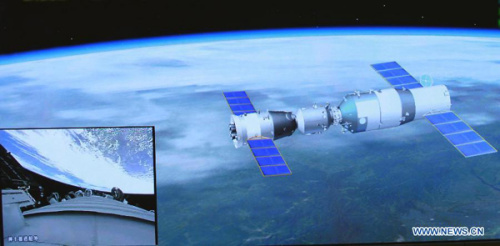

Photo taken on June 13, 2013 shows the screen at the Beijing Aerospace Control Center showing the Shenzhou-10 manned spacecraft conducting an automated docking with the orbiting Tiangong-1 space module and the view outside the propelling module of the Shenzhou-10 manned spacecraft (L, down). China's Shenzhou-10 manned spacecraft successfully completed an automated docking with the orbiting Tiangong-1 space module at 1:18 p.m. Thursday.(Xinhua/Wang Yongzhuo)
China's Shenzhou-10 manned spacecraft successfully completed an automated docking with the orbiting Tiangong-1 space module Thursday, proving China has mastered space docking technology and is confident in space exploration for peaceful purposes.
From initial manned spacecraft flights to space lab docking, China's manned space undertaking achieved huge progress in the past decade.
Shenzhou-10 powered by a Long March-2F carrier rocket is no longer experimental but considered a second only applicable shuttle system in the world besides Russia's Soyuz spaceship for transporting personnel and supplies to orbiting modules.
As a latecomer in space technology, the success China made in a short time was beneficial from the "little step walk" principle, which requires one hundred percent guarantee for each move during aerospace research and exploration.
China successfully sent the country's first astronaut into orbit in 2003 and another seven astronauts, including one female, into space in the next nine years, and mastered automated and manual docking technology, said Cheng Bin, an expert with the U.S. think-tank Heritage Foundation.
He noted that the development of China's manned space flights is amazing and followed prescribed order.
Furthermore, China's policy of "concentrate resources and do big things," provides the space program with the most advanced technology, the most professional working team, and the most talented personnel.
There were 400,000 American aerospace staff behind Neil Armstrong when he walked on the moon. Similarly, 700,000 Chinese aerospace researchers and thousands of departments in China have been contributing to the space mission.
Reaching for the moon has been a long cherished wish for the Chinese nation since ancient time. So China's space program, which pursues peaceful use of space to benefit human kind, helped the Chinese people realize their space dream.
Since the manned spaceflight program launched in 1992, China has actively carried out cooperation with concerned countries and regions in this area in order to promote the progress and development of the world's space technology.
Astronauts of Shenzhou-10 enter Tiangong-1 orbiter
Thu, Jun 13 2013Shenzhou-10 completes docking with space module
Thu, Jun 13 2013Cowling of Shenzhou-X found in NW China
Thu, Jun 13 2013Shenzhou-10 spacecraft successfully launched
Tue, Jun 11 2013President Xi voices congratulations on Shenzhou-10 launch
Tue, Jun 11 2013Copyright ©1999-2018
Chinanews.com. All rights reserved.
Reproduction in whole or in part without permission is prohibited.